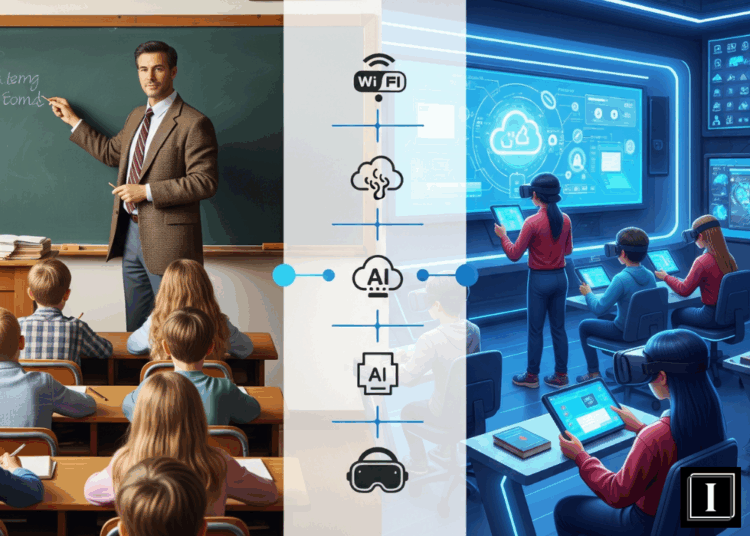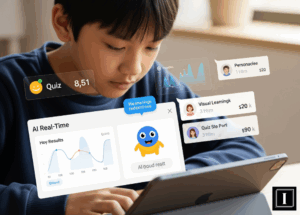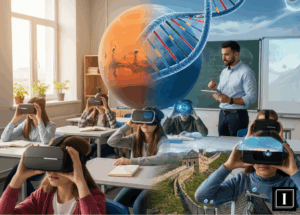From Chalkboards to Cloud: top innovative EdTech trends Revolutionizing Classrooms
Education has evolved far beyond chalkboards and printed textbooks. Today, a wave of innovative EdTech trends is reshaping classrooms, bringing learning into the digital age. With technology like AI, immersive environments, cloud-native systems, and interactive tools, educators can deliver more personalized, engaging, and inclusive experiences. Let’s dive into the most impactful innovative EdTech trends transforming the way we teach and learn in 2025.
1. AI‑Driven Personalized Learning Systems
One of the most powerful innovative EdTech trends is the widespread adoption of AI to personalize learning. AI‑powered platforms (e.g., Squirrel AI, Microsoft Reading Coach, Kira Learning) analyze student behavior and tailor pace, content, and feedback to individual students . Nearly all districts see AI’s potential, with platforms already reducing administrative tasks by up to 42% and enabling personalized instruction for 25% of teachers As educators accumulate data through intelligent dashboards, AI helps close learning gaps and increases retention while freeing teachers to focus on mentorship .
2. Immersive Learning via AR/VR
Immersive realities are another cornerstone in innovative EdTech trends. VR/AR tools allow students to visit historical events or explore scientific phenomena hands‑on from the classroom. Australia’s Mindflight7 has shown that VR can increase knowledge retention by up to 60%, enabling safe, interactive learning—like virtual volcano exploration—without leaving school. With affordable gear and expansive content libraries, VR/AR turns abstract concepts into vivid experiences.
3. Cloud‑Native Platforms & Smart Campus Tools
Cloud-based, integrated platforms are rising as part of the innovative EdTech trends movement. Schools adopt systems that handle attendance, scheduling, grading, communication, and analytics in real time across devices Particularly in K–12, cloud platforms scale effortlessly and enhance remote access, while in higher ed, HyFlex models rely on cloud tools, AI, and video tech to support hybrid cohorts.
4. Adaptive Learning & Microlearning
Adaptive learning and micro‑credentialing are core to innovative EdTech trends. Platforms adjust difficulty based on performance, delivering additional practice or advancing faster learners . Nanolearning modules—short lesson bursts under five minutes—keep Gen Z engaged through quick, gamified content . Additionally, digital badges and micro‑credentials offer flexible skill validation paths.
5. Cybersecurity & Data Privacy
As technologies collect increasing student data, cybersecurity has emerged as a critical innovative EdTech trend. With over 82% of K–12 schools experiencing cyber attacks, districts are enhancing firewall protection, backups, and training staff in phishing defenses . Safe digital learning environments — especially those based in the cloud — depend on robust data-security practices.
6. Mobile‑First Parent Engagement
Parental engagement tools are undergoing digital transformation within the innovative EdTech trends framework. With nearly 95% of parents owning smartphones, districts are implementing mobile apps and text alerts for communication . Real-time updates via apps like ClassDojo help keep families informed and engaged .
7. Interactive Whiteboards & Flipped Classrooms
Interactive whiteboards are emblematic of the shift in innovative EdTech trends, fostering hands-on, media-rich instruction . Meanwhile, flipped classrooms—where students watch lectures at home and solve problems in school—blend with adaptive and cooperative learning to enhance engagement.
8. Social‑Emotional & Collaborative Learning Tools
Tech now supports the emotional and social dimensions of learning. Cloud platforms and virtual spaces create opportunities for digital journaling, peer-interaction, and collaborative projects . Tools like Socrative and platforms with video/audio features enhance emotional intelligence through structured communication and reflection.
Why These Innovative EdTech Trends Matter
These innovative EdTech trends are not fanciful experiments—they align with how learners engage, connect, and succeed in the 21st century. By personalizing instruction, safeguarding data, fostering dynamic learning environments, and strengthening family involvement, technology is remaking education for equity and excellence.
Education is becoming a $7 trillion industry, with digital learning at the core of its next chapter. Whether in K–12 or higher ed, institutions that embrace these trends will offer students smarter, more responsive, and inclusive learning experiences.
Final Thoughts
From AI tutors to VR journeys, cloud-driven campuses to flipped classrooms, innovative EdTech trends are making education more adaptive, immersive, and secure. The vanguard of education now thrives on interactivity, analytics, and real-time communication. Embracing these trends can reduce teacher workload, boost student engagement, and close learning gaps.
Stay ahead in the evolving edu‑tech landscape with IMPAAKT — your top business magazine for deep insights into innovative EdTech trends.













